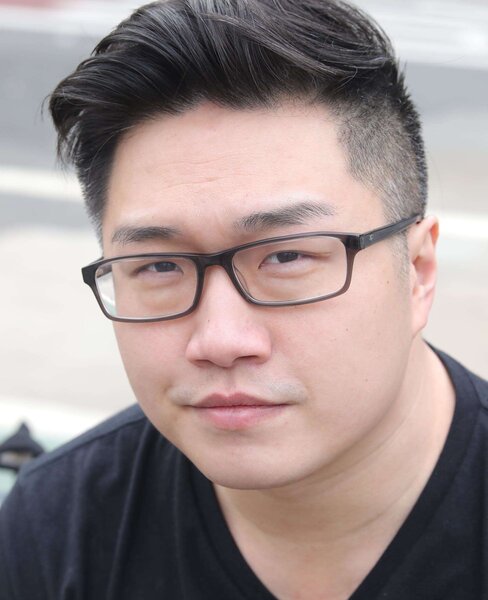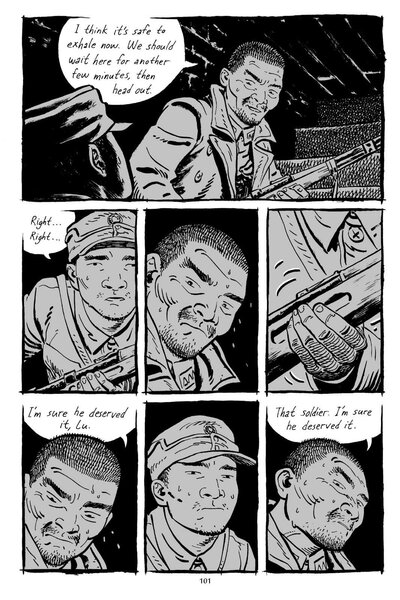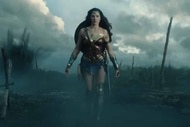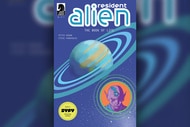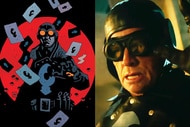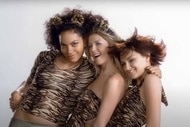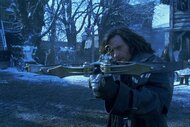Create a free profile to get unlimited access to exclusive videos, sweepstakes, and more!
Ethan Young's 'The Dragon Path' is a venturesome look at growing up Asian American
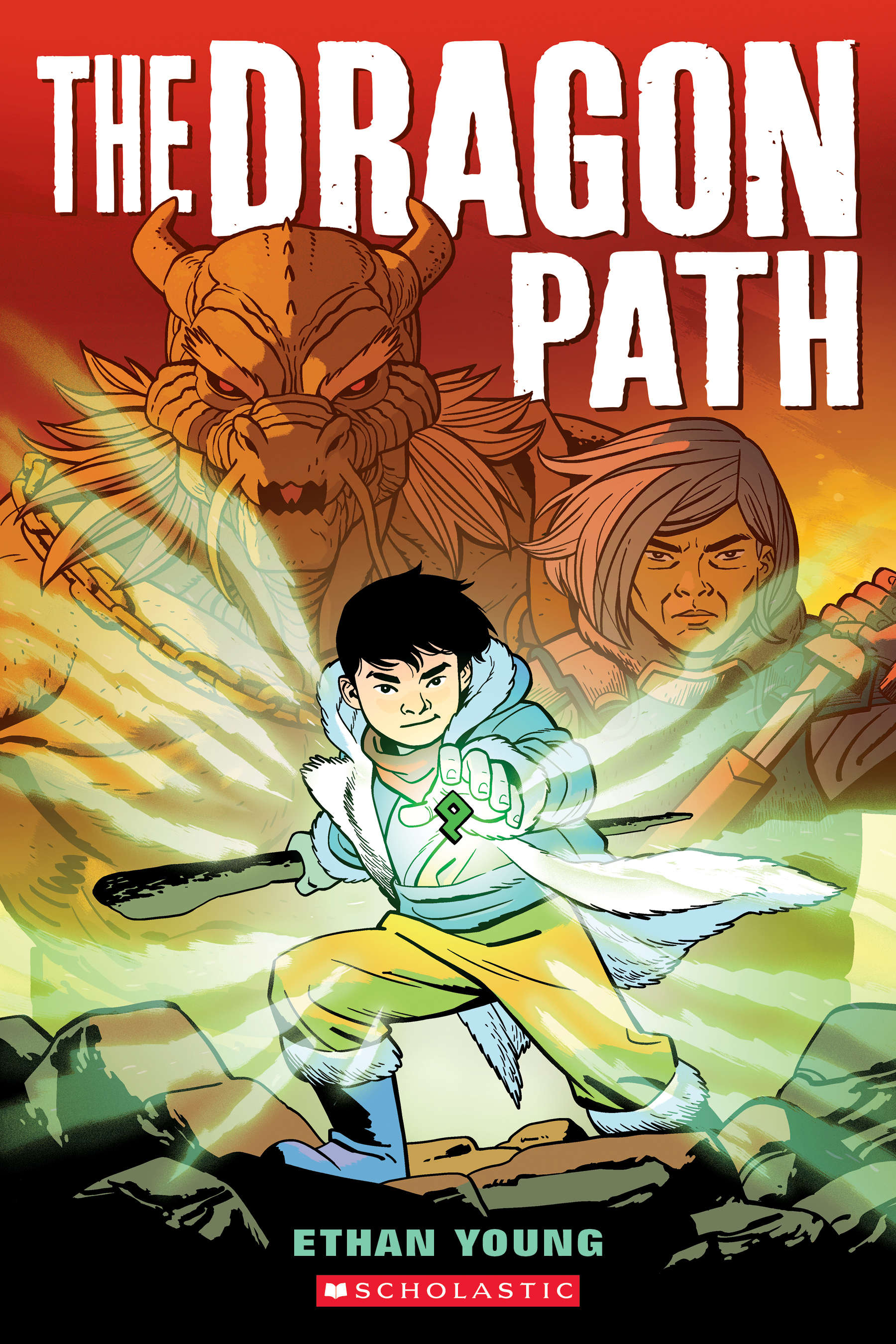
If I grew up with a graphic novel full of dragons, mystical magic orbs, and a giant-sized cat with a unicorn horn shooting blasts of energy, I would have gotten totally lost in this world. I would have voraciously read and re-read the pages of The Dragon Path over and over again. It is the story of thrill-seeking Prince Sing, who attempts to lead his nomadic people, the Wong Clan, to the Old Land in search of a better life. He embarks across the dangerous stretch called the Dragon Path and is separated from his family. With the help of an elderly mythic, a gigantic magical unicorn-cat, and a trusted warrior, Sing might reach his destination.
The comic is the work of writer/artist Ethan Young (Battles of Bridget Lee), who first broke onto the scene with an autobiographical webcomic called Tails, for which he won a 2007 Independent Publisher Book Award for Best Graphic Novel. His follow-up, Nanjing: The Burning City, won the 2016 Reuben Award for Best Graphic Novel. This comic told the story of two Chinese soldiers as they tried to escape the six-week Japanese invasion of Nanjing in the Second Sino-Japanese War — a horrific experience, to say the least. Young hopes The Dragon Path, his latest project, will be the first of many middle-grade action-adventure graphic novels he produces through Scholastic Graphix, following the publisher's other successful series like Amulet and the works of Raina Telgemeier.
The surge in quality in middle-grade comics over the last 10 years has brought in young readers in ways that continue to baffle the "mainstream" comics industry. "For those of us who grew up with more traditional outlets for mainstream and superhero comics, unless we followed it in the industry, we were taken aback by this," Young tells SYFY WIRE. "'Whoa, these things are selling millions of copies?'"
At quick glance, The Dragon Path might appeal to Avatar: The Last Airbender fans, but it might be more like Mad Max: Fury Road for kids. SYFY WIRE spoke with Young about The Dragon Path, the themes of displacement, stepping into responsibility, loyalty to family, and how growing up Asian American influenced the series.
Artistically, The Dragon Path feels like an extension of some of the cover art that you did for the Boom! Studios comic series Ronin Island.
It did feel like an extension of my Ronin Island covers. I was inspired by Hayao Miyazaki comics and I love to do cross-hatching in my art. My favorite artist of all time is Art Adams, who also does cross-hatching. I reached a certain age when I realized I was never going to be one of those artists who make it look so effortless (like Moebius) but what I can do well is cross-hatch, and I can do details that look meticulous. I just basically decided to lean into that a little bit more and look at the stuff that inspired me as a kid. I found an Akira Toriyama (Dragon Ball Z) art book and wanted to create a world that felt really lived in.
As you may have noticed with Nanjing: The Burning City and Battles of Bridget Lee, I am going to try and slip in as many Asian American characters in my stories. Perhaps it's an obligation but we need more diverse stories and I think adding that layer of doing a story that I can relate to, I can make those characters more relatable to someone else who is reading it.
It's admirable you continue to get Asian Americans in your stories and fight the good fight.
I did a 16-page flashback story in the Firefly: Watch How I Soar graphic novel about Hoban "Wash" Washburne and his dad, and everyone else is a person of color. As much as I appreciated Firefly when I was 25, it's weird that you're saying that China is a superpower in the future, and yet there are no Asians anywhere [on the show], so I was going to fix that.
It's easy to use Avatar: The Last Airbender as a reference point but The Dragon Path is its own different thing.
Thank you for noticing that. I do love Avatar: The Last Airbender, which probably taught people more about East Asia than anything they learned in high school. Some probably watched and then did their research and saw all the inspiration throughout Asia. When you love a show, some of those influences are going to seep in. I have seen some of those quick comparisons and I understand. The easiest thing to do is compare it to something that already exists, but the story is different.
Saying that the book is about diaspora is not sexy, because it becomes an academic conversation and that's not the best selling point. But when you read The Dragon Path, it is about diaspora. They're going back to a place that none of those characters have ever been to before. I was born here (in the States) but I've never been to China, and my parents never traveled a lot so we never went back to mainland China a lot. At the same time, you have that connection through it. You can still be proud of that heritage, even without stepping foot, but I think that describes the diaspora experience.
For my son, who is half-Asian and autistic as well, these are going to be very complex ideas that he's going to engage with if he bothers to engage with them. But for me, it was, "Am I Asian enough or am I white enough?" In high school, one of my friends told me in a non-malicious way, "Oh I can tell you're Chinese by the way you speak," and that fed into a self-hatred era of my life. I worked my way to sound more white basically, to the detriment of my Cantonese accent. Whenever my mom hears my Cantonese, another part of her dies, and says, "I can't believe your Cantonese sounds like that." [Laughs.]
In The Dragon Path, Prince Sing comes to understand that the obligations of his royal blood conflict with his desire to be young and careless.
With Prince Sing, [the question is] "what is this kid looking for?" The Old Land is important to him because it's important to his mom. Ultimately, what is really important about his mom was that she was family. So what does this Old Land represent? A connection to his mother? A connection to your past, in many ways, is connecting to yourself. When you want to learn about where you came from, that can teach you how you understand yourself, moving forward in terms of what the previous generations struggled or tackled with.
Sing is forced into doing things because his father, Lord Wong's leadership skills are not good.
I don't know about how you grew up, but when you come from immigrant parents, they tend to be really hard on you. It's like, hey I didn't escape a war-torn country just so you can f*** around here. [Laughs.] (That's first-generation immigrant humor.) So with so many enemies [out to get them], Lord Wong has to be sympathetic. I wanted him to come across as naive, until you realize he is doing this to get back something he lost. One can say he's naive or foolish, but deep down he did it for his son. I wanted to show that may not make him the best leader because he's thinking of the needs of one vs. the needs of many.
That's where the supporting character Lady Hu comes in.
She's a pragmatist. I laid the seeds of the things that happened in the past. If the book is successful, I want to do a prequel of how this woman of royalty becomes a warrior within the ranks, with previous wars when they tried to expand and what was happening versus what was told. As you get older and you learn about the history of many wars you realize, well, that wasn't how we learned it in high school. Even with The Battles of Bridget Lee, I touched on narratives, and false narratives are how you keep selling things to a population. I might touch on that again.
A guardian that has been summoned to protect the Wong Clan manifests as a giant cat with a magical horn on its head. How did you come up with that?
Well, I love cats and I used to be an animal rescuer, but Midnight was actually my wife's cat who sadly passed away a few years ago. I wanted to represent one of my favorite story tropes, which is the surrogate family.
Asians often find a surrogate family around them because so many first-generation Asian Americans had two working parents and rarely saw their parents.
Fellow Asian Americans are typically the quickest to pick up on those themes in my work.
After Nanjing: The Burning City, you shifted to telling lighter stories. Could you ever dip into another story that intense again or was that a one-time thing?
Thankfully, I didn't try to put a book like that out in my 20s because it would've been really bad because I didn't understand the emotional hooks of stories. I figured out how to tell this story, especially as one who wasn't there, has never been to war, or is a journalist, you have to rely on tropes. There's nothing simpler to people than a story that focuses on survival. You're in a war story and setting, you can jump straight into it in an almost deep-dive voyeuristic way and have these two soldiers survive the night.
If I did another story like that, I wouldn't want to repeat that trope and would probably have to find another angle that would keep me motivated for 200 pages of work, which is 2 years' worth of work. That might sound vulgar to say, but it's going to be hard, especially when you're sitting with material that is that morbid. I don't know if I have another dark story that's also historical in me. I'm thankful that the book was as successful as it was, but I wasn't ready for the responsibility that came with it. Not only are you exposing a part of history that's been semi-buried, but that also's not well-known in the west, so it has to be informative and, sad to say, entertaining, otherwise they won't buy it. It's a big weight on your shoulders, especially when you tackle subjects that are of historical relevance.
Has the violence towards Asians affected your artistic or writing process at all?
A little bit. More than anything I grew up in New York City in the Lower East Side and there was a lot of xenophobia, but it was more the product of marginalized communities living in small areas with little resources. That was the difference growing up there and not understanding other communities versus now where we've had a president for the last four years blatantly said s*** that incites people. Media can only do so much. The Matrix was made by two trans women but it was appropriated by a bunch of men's rights activists. For some people, Glenn might have been the only Asian American they saw in The Walking Dead. How much is the media responsible for? How much of a responsibility as a creator are you going to put on yourself?
At the same time, if a kid reads this book and is immersed for two hours, as Will Eisner said, "It's a contract with the reader." I need to do my best to make sure that the characters are either as well represented as possible, or are entertaining as possible, or if I do something where a character is doing something in a stereotypical genre kind of way, it has to be made clear to them, you're not supposed to laugh at this person, you're supposed to laugh with them or vice versa if you're doing something satirical. Those are the fine balances you walk; we're not always successful and I'm sure that I'll eventually have to apologize for creating a character that just wasn't good. I'm potentially working on an adaptation where I realize how important the representation of anyone not white is just so paramount, especially when I know thousands if not tens or hundreds of thousands could read it. So yeah, this time period has made me really reflect and double down on making sure that the characters that I create and mold for the readers are really well done and responsible.
The Dragon Path is out now, available at comic shops, book stores, and wherever Scholastic books are available. Be sure to check out our nine-page preview below.
